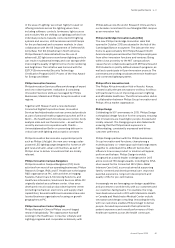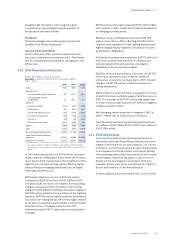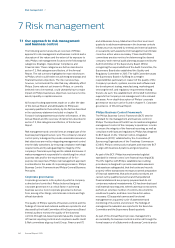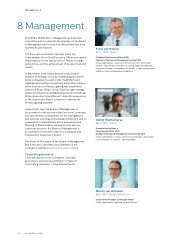Philips 2015 Annual Report Download - page 64
Download and view the complete annual report
Please find page 64 of the 2015 Philips annual report below. You can navigate through the pages in the report by either clicking on the pages listed below, or by using the keyword search tool below to find specific information within the annual report.Risk management 7
64 Annual Report 2015
7 Risk management
7.1 Our approach to risk management
and business control
The following section presents an overview of Philips’
approach to risk management and business controls and a
description of the nature and the extent of its exposure to
risks. Philips’ risk management focuses on the following risk
categories: Strategic, Operational, Compliance and
Financial risks. These categories are further described in
section 7.2, Risk categories and factors, of this Annual
Report. The risk overview highlights the main risks known
to Philips, which could hinder it in achieving its strategic and
financial business objectives. The risk overview may,
however, not include all the risks that may ultimately affect
Philips. Some risks not yet known to Philips, or currently
believed not to be material, could ultimately have a major
impact on Philips’ businesses, objectives, revenues, income,
assets, liquidity or capital resources.
All forward-looking statements made on or after the date
of this Annual Report and attributable to Philips are
expressly qualified in their entirety by the factors described
in the cautionary statement included in chapter 19,
Forward-looking statements and other information, of this
Annual Report and the overview of risk factors described in
section 7.2, Risk categories and factors, of this Annual
Report.
Risk management and controls forms an integral part of the
business planning and review cycle. The company’s risk and
control policy is designed to provide reasonable assurance
that objectives are met by integrating management control
into the daily operations, by ensuring compliance with legal
requirements and by safeguarding the integrity of the
company’s financial reporting and its related disclosures. It
makes management responsible for identifying the critical
business risks and for the implementation of fit-for-
purpose risk responses. Philips’ risk management approach
is embedded in the areas of corporate governance, Philips
Business Control Framework and Philips General Business
Principles.
Corporate governance
Corporate governance is the system by which a company
is directed and controlled. Philips believes that good
corporate governance is a critical factor in achieving
business success. Good corporate governance derives
from, among other things, solid internal controls and high
ethical standards.
The quality of Philips’ systems of business controls and the
findings of internal and external audits are reported to and
discussed by the Audit Committee of the Supervisory Board.
Internal auditors monitor the quality of the business
controls through risk-based operational audits, inspections
of financial reporting controls and compliance audits. Audit
& Risk committees at group level (Group, Finance and IT)
and at Business Group, Market and Function level meet
quarterly to address weaknesses in the business controls
infrastructure as reported by internal and external auditors
or revealed by self-assessment of management, and to take
corrective action where necessary. These Audit & Risk
committees are also involved in determining the desired
company-wide internal audit planning as approved by the
Audit Committee of the Supervisory Board. Whilst
recognizing the responsibilities of the Audit Committee, the
Supervisory Board also established the Quality and
Regulatory Committee in 2015. The Q&R Committee assist
the Supervisory Board in fulfilling its oversight
responsibilities particularly in respect of the quality of the
Company’s products, systems, services and software and
the development, testing, manufacturing, marketing and
servicing thereof, and regulatory requirements relating
thereto. As such, the establishment of the Q&R Committee
supports the Company’s risk management in the relevant
risk areas. An in-depth description of Philips’ corporate
governance structure can be found in chapter 11, Corporate
governance, of this Annual Report.
Philips Business Control Framework
The Philips Business Control Framework (BCF) sets the
standard for risk management and business control in
Philips. The objectives of the BCF are to maintain integrated
management control of the company’s operations, in order
to ensure the integrity of the financial reporting, as well as
compliance with laws and regulations. Philips has designed
its BCF based on the “Internal Control-Integrated
Framework (2013)” established by the Committee of
Sponsoring Organizations of the Treadway Commission
(COSO). Philips continuously evaluates and improves BCF
to align with business dynamics and good practice.
As part of the BCF, Philips has implemented a global
standard for internal control over financial reporting (ICS).
The ICS, together with Philips’ established accounting
procedures, is designed to provide reasonable assurance
that assets are safeguarded, that the books and records
properly reflect transactions necessary to permit preparation
of financial statements, that policies and procedures are
carried out by qualified personnel and that published
financial statements are properly prepared and do not
contain any material misstatements. ICS has been deployed
in all material reporting units, where business process owners
perform an extensive number of controls, document the
results each quarter, and take corrective action where
necessary. ICS supports business and functional
management in a quarterly cycle of assessment and
monitoring of its control environment. The findings of
management’s evaluation are reported to the Executive
Committee and the Supervisory Board quarterly.
As part of the Annual Report process, management’s
accountability for business controls is enforced through the
formal issuance of a Statement on Business Controls and a
























